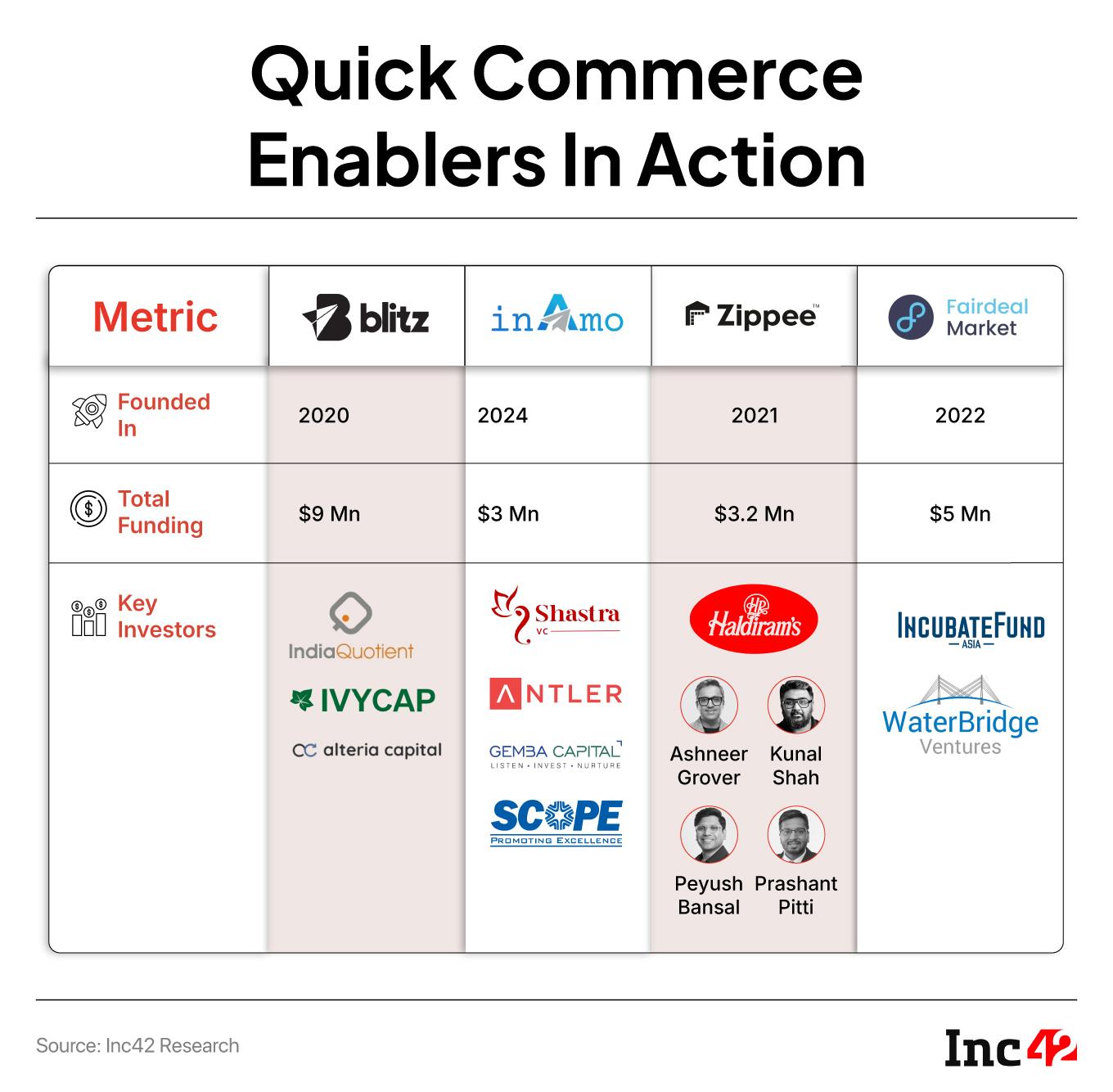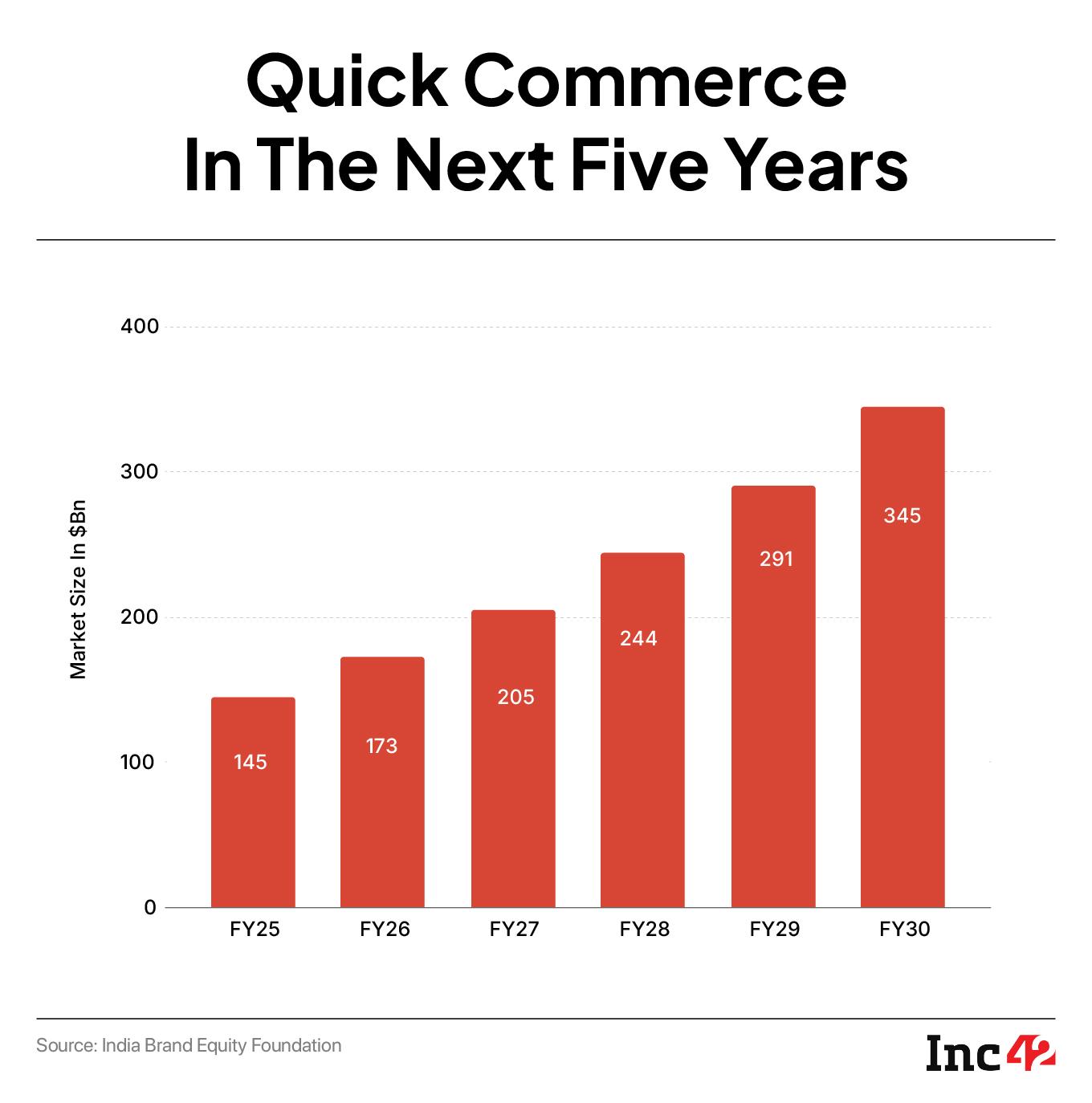Who does not want to take advantage of the great Indian quick commerce movement? What started with Blinkit, Zepto, and Instamart as an endeavour to cater to convenience and speedy deliveries has today become a fierce battleground, with several players (both new and incumbents) now vying for a share of the quick commerce pie.
Despite the optimism, several challenges eclipse this realm. For context: the QC model demands an entirely new layer of operational precision, from setting up expensive dark store networks to managing dynamic inventory and ensuring efficient last-mile delivery.
Building this ecosystem is no small feat, and that’s where a new generation of startups, often referred to as quick commerce enablers, is stepping in.
While platforms such as Blinkit, Zepto, or Instamart focus on generating consumer demand, these enablers, namely Blitz, Inamno, Fairdeal Market, and Zipee, among others, are handling the crucial behind-the-scenes work, from store and target management to last-mile optimisation.
These startups are tackling the structural gaps across the value chain, developing solutions that make quick commerce viable beyond metro cities. Some are building micro cold-chain networks to support categories that require precise temperature control, fresh produce, meat, or even pharmaceuticals, while others are rethinking how last-mile logistics can be made faster and more sustainable.
Industry stakeholders believe we are entering an infrastructure moment for quick commerce, a turning point similar to what SaaS, warehousing, and digital payments brought to the ecommerce boom.
The Many Hurdles In Quick Commerce“The focus is shifting from rapid scale to profitability and sustainable growth, and this transition demands stronger, smarter, tech-driven infrastructure. These early signs suggest that the sector is inching toward an Industry 5.0–style transformation,” said Vikram Gupta, the founder and managing partner of IvyCap Ventures, which has investments in quick commerce logistics enabler Blitz.
While conversations around quick commerce often focus on automation and robotics, most of these enablers are currently grounded in supply chain enablement.
Their main focus right now is to build strong, tech-driven networks that enable quick deliveries — covering everything from predicting demand and managing stock to processing orders and handling last-mile delivery, Mayank Varshney, founder of Blitz, said.
Inamo, founded by former Dunzo VP Sumit Anand and ex-ApnaKlub product head Rupesh Thakare, works with horizontal QC platforms such as Blinkit, Zepto, and Instamart, as well as with brands that can generate their own demand directly.
Once orders are generated, Inamo steps in to manage everything from target allocation to last-mile delivery. It operates as a layer of infrastructure, integrating technology, logistics, and operations to deliver seamless execution. Inamo describes itself as an end-to-end quick commerce enablement company.
Blitz, on the other hand, focuses squarely on enabling brands to offer 60-minute delivery. The company partners with consumer-facing brands to build rapid delivery capabilities that were once limited to large marketplaces. Blitz provides the technology and fulfilment infrastructure that lets these brands maintain their D2C independence while matching the delivery speeds of major ecommerce marketplaces and quick commerce platforms.
Powered by quick commerce-like dark stores, dedicated in-house teams for last-mile deliveries and a tech ecosystem, Zippee provides a same-day delivery window for D2C brands.
It is now operating across 21 cities with over 85 active properties. It manages nearly 3 Lakh square feet of dark store and warehousing space, powering deliveries ranging from 30 to 120 minutes, Madhav Kasturia, founder & CEO of Zippee, claimed.
In a nutshell, these companies are taking end-to-end responsibility for fulfilment, optimising every step — from how inventory is stored and packed to how it reaches the customer’s doorstep.
“Automation, however, is still in its infancy in India. Given that labour remains relatively affordable and flexible, full-scale warehouse robotics like automated guided vehicles (AGVs) have yet to become mainstream,” Anand of Inamo said.
He added that the next wave will likely include assisted picking systems, IoT-based inventory tracking, and AI-driven route optimisation, steps that will incrementally improve efficiency and accuracy.

When it comes to monetisation and revenue streams, most quick commerce enablers today operate on a pay-per-order or transaction-linked model, where they charge based on the gross transaction value (GTV) generated by the brand.
Subscription-based models have not gained significant traction yet in the quick commerce ecosystem.
“The market favours flexible, on-demand fulfilment, allowing customers to order whenever they need, rather than committing in advance,” Anand said.
Some enablers are following a managed-store model, where they take responsibility for the brand’s entire quick commerce operations. In this setup, revenue comes from a combination of management fees and performance-based incentives tied to operational efficiency.
They also generate additional revenue by improving operations and using technology — through predictive inventory management, consumer analytics, and efficiency enhancements.
“In a high-volume, low-margin situation, hybrid models tend to work much better. It usually requires a combination of transaction-based pricing along with other models. A purely SaaS-based model can be challenging in this context, which is why we can expect more innovative pricing models to emerge over time,” Ivycap’s Gupta said.
In terms of categories, grocery, electronics, beauty, and fashion remain the most active sectors. However, newer opportunities are emerging in vertical segments like personal care, haircare, and wellness products. Beauty, in particular, has shown strong early adoption and growth. Over time, electronics and other niche categories are expected to gain traction as the infrastructure and consumer readiness expand.
Moreover, the enabler startups are beginning to serve deeper categories such as fresh produce, pharmaceuticals, and other specialised segments, which will further drive growth opportunities.

The big question now is — as quick commerce majors continue to burn cash at scale, can enabler startups help improve unit economics and bring these players closer to breaking even?
Enabler solutions focus on improving operational efficiencies across the supply chain, logistics, and workforce management. By optimising specific processes — from dark store operations to last-mile delivery routing — they can meaningfully impact gross margins.
“In the short term, efficiency gains could improve profitability by 5% to 10%, and over time, as multiple technologies and process optimisations are implemented, this impact could rise to 20–30%,” an industry stakeholder said.
Zipee’s Kasturia notes that the benefits go beyond simple cost savings. “It’s more than just saving the last dollar — it’s about outsourcing the operational headache.”
Many of these enablers allow quick commerce players to focus on their core business — growing their brand and sales.
He added that while cost reductions of 5–7% can be achieved through shared services and operational efficiencies, the real value lies in offloading the entire burden of running dark stores and delivery networks to a partner who treats it as their primary business.
In addition, automation in dark stores and intelligent routing can gradually offset rising labour, rider, and real estate costs, especially in metros. Over time, these technology-driven efficiencies are expected to play a critical role in improving unit economics and sustaining long-term profitability for quick commerce players.
[Edited by Shishir Parsher]
The post Behind The Scenes: How A New Breed Of Startups Is Powering India’s Quick Commerce Boom appeared first on Inc42 Media.
You may also like

Pakistani airstrike in Balochistan kills six civilians as military operations escalates

Trump tariffs: India's smart strategy could be working

UIDAI launches SITAA to strengthen India's ID Tech ecosystem

Chhattisgarh: 'Laika Ghar' to combat malnutrition among children

Six of family hospitalised after consuming wild mushrooms in Thiruvananthapuram






